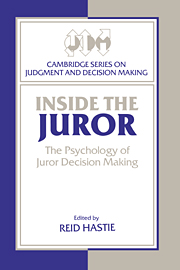Book contents
- Frontmatter
- Contents
- Series preface
- List of contributors
- Editor's preface
- Acknowledgments
- Part I Models of juror decision making
- Part II Commentaries
- 9 Notes on the sampling of stimulus cases and the measurement of responses in research on juror decision making
- 10 Sausages and the law: Juror decisions in the much larger justice system
- 11 A rational game theory framework for the analysis of legal and criminal decision making
- 12 Why do jury research?
- 13 Two conceptions of the juror
- 14 A mathematician comments on models of juror decision making
- Index of names
- Index of subjects
14 - A mathematician comments on models of juror decision making
Published online by Cambridge University Press: 04 August 2010
- Frontmatter
- Contents
- Series preface
- List of contributors
- Editor's preface
- Acknowledgments
- Part I Models of juror decision making
- Part II Commentaries
- 9 Notes on the sampling of stimulus cases and the measurement of responses in research on juror decision making
- 10 Sausages and the law: Juror decisions in the much larger justice system
- 11 A rational game theory framework for the analysis of legal and criminal decision making
- 12 Why do jury research?
- 13 Two conceptions of the juror
- 14 A mathematician comments on models of juror decision making
- Index of names
- Index of subjects
Summary
In this comment I will briefly address three topics. First, some comments on the aptness of the Bayesian model as a description of the way people think; in particular, how jurors think. Second, a comment on the application of mathematical models in general to the behavioral sciences. Third, some suggestions for specific directions in jury research that would be of particular interest to mathematicians and statisticians.
The Bayesian model
Let me start with a few remarks on the Bayesian picture of belief and belief revision. Specifically, I want to talk about some of the goals a researcher might want to accomplish when using a Bayesian model. First, the researcher might want to use the model descriptively; as a description of the mental processes and behavior of an actual decision maker. Unfortunately, it has become increasingly clear that human behavior does not approximate the prescriptions of a Bayesian model. Work by Tversky and Kahneman (1974) and others has shown that people exhibit substantial violations of the laws of probability in making assessments of probability. In a sense this conclusion has positive implications for the Bayesian enterprise. If the mathematical theory of probability corresponded to our intuitions at all points, we wouldn't need it. It is precisely because the theory on occasion tells us things that seem initially counterintuitive (e.g., revealing errors of judgment in problems such as the “birthday paradox,” the “regression fallacy,” and reasoning about conditional probabilities) that it is useful.
- Type
- Chapter
- Information
- Inside the JurorThe Psychology of Juror Decision Making, pp. 263 - 270Publisher: Cambridge University PressPrint publication year: 1993



